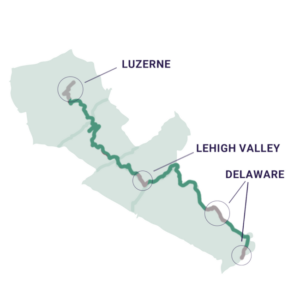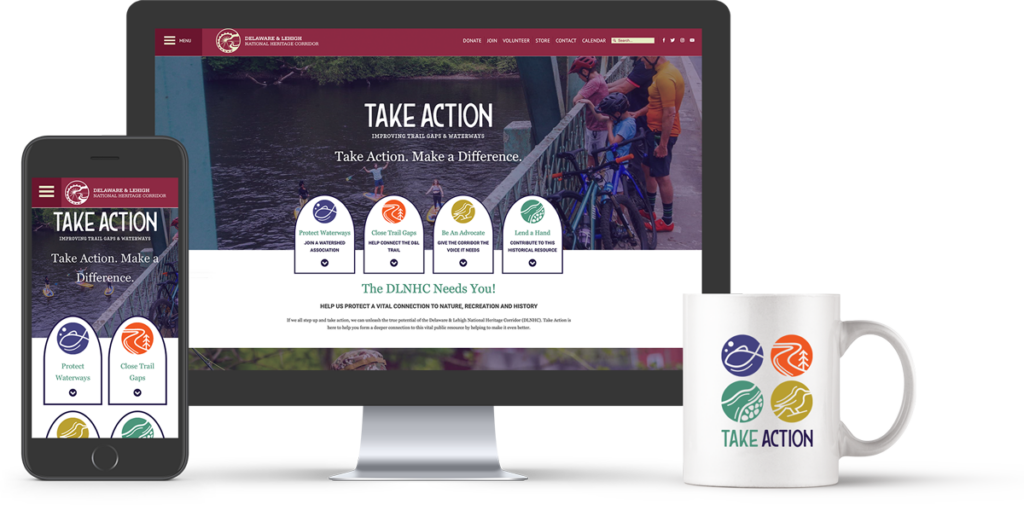Take Action
Help Us Protect a Vital Connection to Nature, Recreation and History.
DLNHC teamed up with Kudu to enhance their outreach to trail users! The Delaware & Lehigh National Heritage Corridor (DLNHC) launched the exciting Take Action campaign, which focused on improving water quality and trail gaps within the corridor. Our mission was to ignite a passion for this remarkable natural, historical, and cultural resource among both current and future trail enthusiasts. And, make a real difference by generating new levels of activity, interest, and ownership within the community.
Research
In order to learn the most we could about the Trail, we met up with passionate D&L Trail users from the Anthracite, Lehigh Valley, and Delaware regions to brainstorm. This Super Group shared their perceptions and wishlist items for their beloved trail. We also created and sent out email surveys in English and Spanish to gain further insight from individuals not included in the small group discussion. Their valuable input drove our mission to inspire a sense of ownership in every citizen, to feel empowered to make a positive impact on the quality of the D&L’s waterways and trails.

Delaware and Lehigh River Awareness & Education
There are many components to improving water quality. It takes landowners, local watersheds and trail members be on the same page to move the needle. Using statistics to specify how great the need is shows how imperative it is to activate DLNHC members to Take Action.

What is a watershed?
We found a significant percentage of people didn’t know what a watershed was. So, we created illustrations to help further explain what the written copy describes. We also provided a linked list of local watershed associations for members to learn more about existing watershed associations or how to be involved if a location doesn’t currently have a watershed.
Illustration of Delaware River Basin, tributaries, watershed and sub-watersheds. |
 |
|
|
 |
Illustration of local watershed associations that exist along the DLNHC. |
D&L Trail Gap Awareness & Education
There are many components to connecting trail gaps. It takes landowners, local legislators and trail users to be on the same page to move the needle. Again, we are using statistics to specify how great the need is and show how imperative it is to activate DLNHC members to Take Action.

What is a Trail Gap vs. Trail Closure?
Trail gaps are areas where the trail doesn’t exist yet, while trail closures are temporarily closed sections of trail due to damage or maintenance. Trail closures typically reopen in a relatively short time (months to a few years), while Trail Gaps take much longer to officially open (years to decades). To contribute to connecting trail gaps you can attend municipal meetings as a passionate supporter of the Corridor, and let your voice be heard in advocating for our shared vision. Or write a heartfelt letter to elected officials, urging them to prioritize the protection and preservation of our trails and water resources.
Illustration of the Corridor highlighting the major trail gaps that exist along the D&L. |
 |
Other Ways to Gain Support
Engage your audience to take the next step with direct mailers, social media posts, and swag items like stickers! Get involved in protecting and improving this incredible regional resource. Donate money to support vital initiatives like water quality protection, trail preservation, and new trail connections. Become a member of the DLNHC community and be a part of their journey to safeguard our heritage and natural treasures. Or volunteer for projects and events that enhance the beauty and accessibility of the trails and waterways. Your hands-on effort can make a real difference!
 |
Social media posts to be shared by DLNHC partners to spread the reach of the campaign. |
Direct mail postcards with a QR code to website for easy access. |
 |


